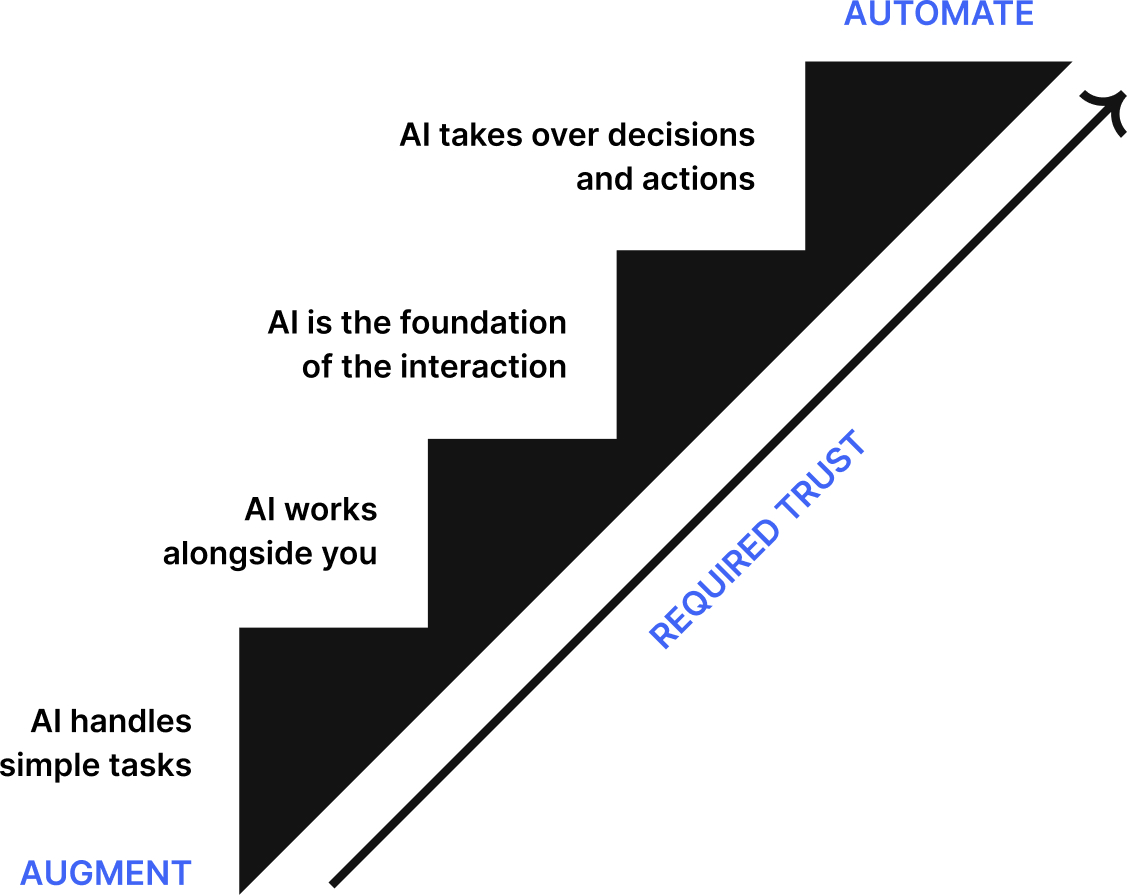
Buyer , User , Startups , Scaleups — 03.20.2024
Define Your AI-Powered Product Strategy
Katie Lukes, VP, Product Strategy & Research

AI is quickly becoming a cornerstone for innovative products. Leveraging AI enhances your product’s capabilities for your users and, if utilized the right way, offers a competitive edge in the market.
But as expectations rise and you hear demands to implement AI from every side, how do you do it effectively? In this article, we’ll share our framework to identify the role of AI in your business, make strategic roadmap decisions and build better AI-powered products.
The Role of AI in Your Business
The first step in crafting an AI-powered product strategy involves understanding the unique role AI can—and should—play within your business. This understanding is crucial for making strategic roadmap decisions and developing products that genuinely benefit from the use of AI.
Consider key factors before you make the leap to an AI-powered feature or product:
- Is your market ready for an AI solution?
- Will they trust it?
- Is your internal team ready to dedicate the bandwidth and learning that will be required?
- Do you have the right data to power an AI solution, and is it in a state to use in this type of solution?
Consider the readiness of your business internally and market externally to be your key indicators in determining whether now is the time to implement AI.
Identify the Right Problems
You want to build valuable products to solve real needs of your customers. So, what are the problems that you’re solving for your customers today? Then, which of those problems are appropriate for AI to help solve?
We recommend a two-step approach: First, map your user journey and the challenges your users have along the way. Then, identify the challenges that AI would be best suited to solve. By focusing on the right problems, you can harness AI to address specific challenges effectively rather than haphazardly.
We’ve identified four categories of user problems that AI is great at solving. Use these as a guide in identifying the challenges that you might solve with AI:
- Tediousness: Identify tasks that consume significant time and attention from your users. AI can automate these tasks, freeing up users to focus on more strategic activities.
- Confusion: Look for areas where technical jargon or overwhelming choices hinder the user experience. AI can simplify these processes, making them more accessible and user-friendly.
- Impossibility: Some challenges are beyond human capability, often due to the sheer volume of data. AI can process and synthesize vast amounts of information, making the impossible, possible.
- Unfamiliarity: When users need inspiration or specialized knowledge, AI can offer recommendations and guidance, enhancing the decision-making process.
Choosing the Right Depth
After you’ve determined the right problems for AI to solve, consider how much control to give AI when completing tasks. Just like there are categories for appropriate problems for AI to solve, there are appropriate levels of depth to apply to how AI gets the job done.
We’ll say it again—just because AI has the ability to do something, that doesn’t mean it always should.
Thinking about AI as augmenting your user experience versus automating it can help you determine its role and how far to take it.

Augmenting your user experience with AI means adding small AI features, while your human users are performing most of the work. For example, AI in a project management software might help summarize meeting notes and populate a to-do list. In this situation, the stakes are low and humans save time.
Automating your user experience with AI, on the other hand, is when the AI fully takes over tasks from your human users. It’s appropriate when your users lack the knowledge to be able to do something, or when the tasks are boring, repetitive, or dangerous. An example might be a credit card company using AI to discover fraud and send alerts.
An important consideration for deciding how much to automate your user experience: the higher the stakes around the automated task, the more trust you’ll have to build with users.
Building Trust with AI-Powered Products
How do you build trust with AI-powered products?
We have five recommendations for your AI user experience to get started:
- Show your work. Always share sources and context, and be transparent with how results are generated. Often what users don’t trust is the method AI used to generate the result, so show them how.
- Be humble. Acknowledge that there’s room for error, and that AI can make mistakes. AI won’t always get it right, so don’t overpromise. Use text to provide caveats along the way.
- Let the user take the wheel. AI usage should be flexible enough to fit users’ unique needs and allow them to change the parameters when appropriate. AI still requires human direction to get to the best results, so build that into your design.
- Provide an exit. Don’t force users to employ AI when it isn’t working for them. Not everyone will prefer to use AI to complete a task, so to avoid frustration, give them a way to work around it.
- Address bias. It’s no secret that representation isn’t 100% and results can be skewed.
That last recommendation is incredibly important. Within AI, we typically see two types of bias: algorithmic and societal.
Algorithmic bias occurs when the algorithms the AI was trained on was composed of biased data. Societal bias happens when public assumptions or norms create blind spots in the for the AI. Neither form of bias is good, and both need to be accounted for.
To mitigate algorithmic and societal bias as much as possible, consider:
- Creating diverse teams
- Scrutinizing data sources
- Testing with underrepresented groups
Prioritize the Work & Take Action
You have a framework for integrating AI into your product strategy, but getting started is the hardest part. What do you do next?
Start with prioritization.
Prioritization helps teams think through what to build, in what order and when. It can help you map out realistic goals and product timelines, so that you can put this strategy into play.
When prioritizing the work, be sure to factor in:
- Company strategy and goals
- User goals
- Development capabilities
- Effort and impact of features
Those are good fundamentals to keep in mind for prioritizing any product work, but AI can sometimes be tricky. Consider these final tips for prioritizing AI product work:
- Have the right people in the room. Lean on engineering and data science for their expertise.
- Understand the data. Build in activities for data strategy and quality.
- Include time to iterate. Experimentation and testing can take longer than you’d think.
- Outline metrics to track. Include outcomes, success measures and non-success metrics.
By focusing on the right problems, choosing the appropriate level of depth, building trust and prioritizing the work, you can develop AI-powered products that enhance user experience, solve pertinent problems and serve your market effectively.
And if you need a partner in this process, let us know. We’re here to help.

